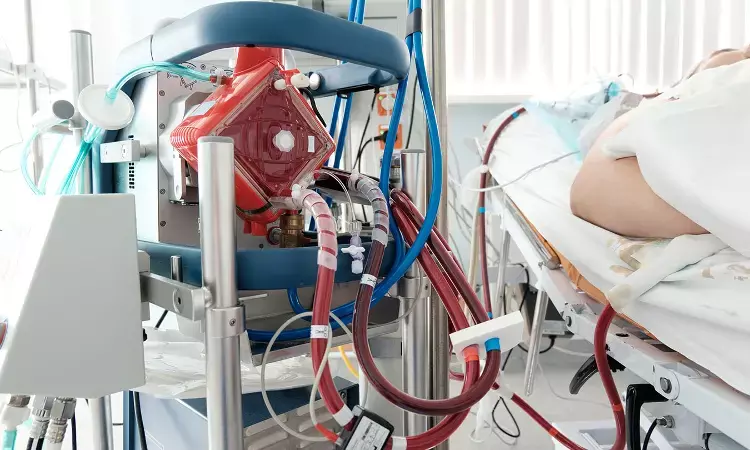- Home
- Medical news & Guidelines
- Anesthesiology
- Cardiology and CTVS
- Critical Care
- Dentistry
- Dermatology
- Diabetes and Endocrinology
- ENT
- Gastroenterology
- Medicine
- Nephrology
- Neurology
- Obstretics-Gynaecology
- Oncology
- Ophthalmology
- Orthopaedics
- Pediatrics-Neonatology
- Psychiatry
- Pulmonology
- Radiology
- Surgery
- Urology
- Laboratory Medicine
- Diet
- Nursing
- Paramedical
- Physiotherapy
- Health news
- Fact Check
- Bone Health Fact Check
- Brain Health Fact Check
- Cancer Related Fact Check
- Child Care Fact Check
- Dental and oral health fact check
- Diabetes and metabolic health fact check
- Diet and Nutrition Fact Check
- Eye and ENT Care Fact Check
- Fitness fact check
- Gut health fact check
- Heart health fact check
- Kidney health fact check
- Medical education fact check
- Men's health fact check
- Respiratory fact check
- Skin and hair care fact check
- Vaccine and Immunization fact check
- Women's health fact check
- AYUSH
- State News
- Andaman and Nicobar Islands
- Andhra Pradesh
- Arunachal Pradesh
- Assam
- Bihar
- Chandigarh
- Chattisgarh
- Dadra and Nagar Haveli
- Daman and Diu
- Delhi
- Goa
- Gujarat
- Haryana
- Himachal Pradesh
- Jammu & Kashmir
- Jharkhand
- Karnataka
- Kerala
- Ladakh
- Lakshadweep
- Madhya Pradesh
- Maharashtra
- Manipur
- Meghalaya
- Mizoram
- Nagaland
- Odisha
- Puducherry
- Punjab
- Rajasthan
- Sikkim
- Tamil Nadu
- Telangana
- Tripura
- Uttar Pradesh
- Uttrakhand
- West Bengal
- Medical Education
- Industry
LAVA ECMO Might Benefit Patients with Cardiogenic Shock

Cardiogenic shock (CS) occurs in 5%-10% of cases of myocardial infarction (MI) and is accompanied by 30-day mortality as high as 60%. Early findings from a recent study suggest that the use of left atrial venoarterial cannulation during extracorporeal membrane oxygenation—a technique known as LAVA ECMO is safe and effective in patients with cardiogenic shock complicated by biventricular failure. The study findings were presented at the Technology and Heart Failure Therapeutics (THT) 2022 meeting in New York on February 02, 2022.
Conventional venoarterial (VA) ECMO is commonly used in patients presenting with biventricular failure with cardiogenic shock as a bridge to myocardial recovery, durable left ventricular assist device, or cardiac transplantation. However, LAVA-ECMO has advantages over these existing alternatives.
LAVA-ECMO utilizes a single cannula (VFEM024, Edwards Lifesciences, Irvine, CA) with a long fenestrated segment (15 cm) decompressing both the left and right atria. The cannula is inserted using femoral venous access, necessitating transseptal puncture and enabling biventricular support while minimizing arterial access.
Dr Waleed Al-Darzi and his team conducted a single centred, retrospective analysis with 25 patients treated at the Henry Ford Hospital, Detroit MI, by analyzing hemodynamic changes and in-hospital outcomes. The most common comorbidities among 25 patients were hypertension (64%) and diabetes mellitus (36%). Fully 68% of patients had RV dysfunction, with a mean RV systolic pressure of 53 mm Hg. Valve disease was common: aortic, mitral, and tricuspid regurgitation were seen in 32%, 28%, and 24% of patients. One-quarter had severe aortic stenosis, and 4% had severe mitral stenosis. They performed ipsilateral reperfusion sheaths and intracardiac echo in 88% of cases.
Key findings of the study:
- Upon analysis, the researchers noted that several hemodynamic measures such as heart rate, mean right atrial pressure, mean pulmonary arterial pressure, cardiac index, mean systemic arterial pressure, cardiac power output, pulmonary artery pulsatility index improved after initiation of LAVA ECMO.
- They noted only 8% involved additional forms of LV unloading, and 80% were ultimately decannulated.
- They observed that most patients went on to receive a valve replacement (44%), 12% had a heart transplant, 8% received a durable left ventricular assist device, 4% underwent CABG surgery, and 4% had ventricular septal defect surgical repair.
- They highlighted that for 16%, the LAVA ECMO was a "bridge to decision."
- However, they reported that three patients died while on ECMO.
- In-hospital complications included non-access-site bleeding (28%), infection (28%), new renal replacement therapy (20%), access-site hematoma (12%), stroke (12%), limb ischemia (8%), and hemolysis (4%).
- They noted that thirteen patients survived discharge, amounting to a mortality rate of 48%.
"It's a great tool in experienced hands", said Dr Waleed Al-Darzi. He stressed that the new report is a small, single-centre study that didn't compare directly between LAVA ECMO and other forms of support. However, the findings suggest positive cardiopulmonary hemodynamic changes. He also urged for further prospective studies.
For further information:
Al-Darzi W. Utilization of left-atrial venous arterial extracorporeal membrane oxygenation for biventricular failure in cardiogenic shock. THT 2022.
Medical Dialogues Bureau consists of a team of passionate medical/scientific writers, led by doctors and healthcare researchers. Our team efforts to bring you updated and timely news about the important happenings of the medical and healthcare sector. Our editorial team can be reached at editorial@medicaldialogues.in.
Dr Kamal Kant Kohli-MBBS, DTCD- a chest specialist with more than 30 years of practice and a flair for writing clinical articles, Dr Kamal Kant Kohli joined Medical Dialogues as a Chief Editor of Medical News. Besides writing articles, as an editor, he proofreads and verifies all the medical content published on Medical Dialogues including those coming from journals, studies,medical conferences,guidelines etc. Email: drkohli@medicaldialogues.in. Contact no. 011-43720751


